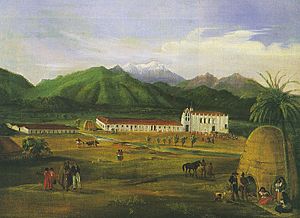Toviscanga facts for kids
Toviscanga was an important village that was once home to the Tongva people. Today, this area is part of Mission San Gabriel Arcángel in San Gabriel, California. Sometimes, the village was also called Tobiscanga. Another name, Tuvasak, was used by the Payómkawichum people for this same village. Toviscanga was located very close to another village called Sibagna.
Contents
What Was Toviscanga?
Toviscanga was a lively village where the Tongva people lived for many years. The Tongva are a Native American group who have lived in the Los Angeles Basin area for thousands of years. Their villages were often built near rivers or other water sources.
Where Was Toviscanga Located?
The village of Toviscanga was located in what is now San Gabriel, California. It was a significant place for the Tongva people. Its exact spot became the site of the famous Mission San Gabriel Arcángel.
The Mission's New Home
In 1771, Spanish missionaries first built Mission San Gabriel Arcángel nearby. However, a big flood destroyed this first building. Because of the flood, the missionaries decided to move the mission. In 1776, they rebuilt the mission at the site of the Toviscanga village. This new location was safer and became the permanent home for the mission.
An important Spanish leader named Junipero Serra confirmed this new location. In 1778, he wrote about the mission, calling it "Mission of the Holy Prince the Archangel San Gabriel of the Earthquakes, also known as Toviscanga." This shows how closely the mission and the village were connected.
The Tongva Language of Toviscanga
The people living in Toviscanga spoke a special kind of the Tongva language. This specific way of speaking was known as the San Gabriel dialect. It was unique to the people of this area.
What Happened to the Language?
Over time, fewer and fewer people spoke the Tongva language. By 1875, only a few older men were still known to speak the San Gabriel dialect. A Franciscan missionary named Jose Maria Zalvadeas tried to help. He gave speeches and translated Christian prayers into the Tongva language. He even wrote down the language's rules in a dictionary around 1824. Sadly, by 1882, this important dictionary was lost, and the dialect was almost gone.


